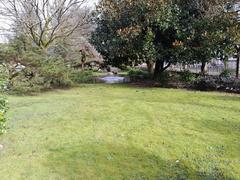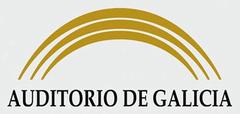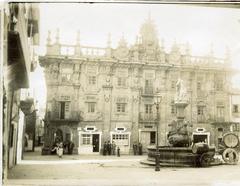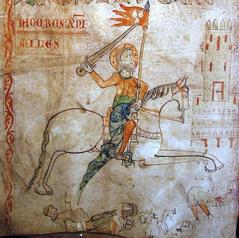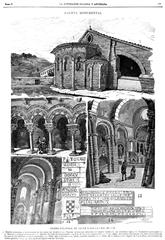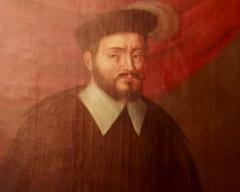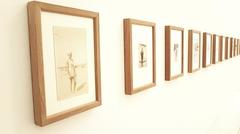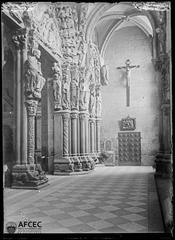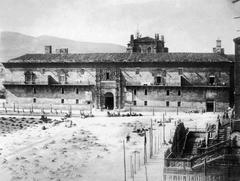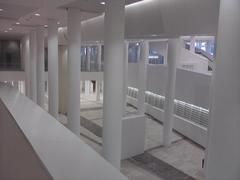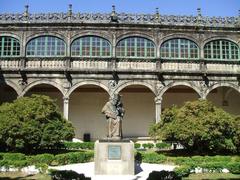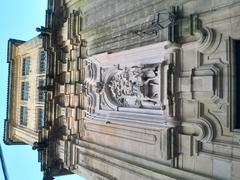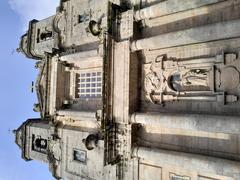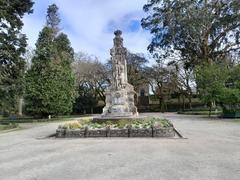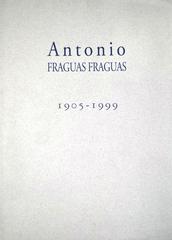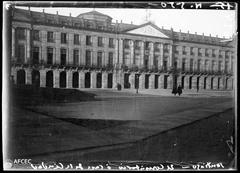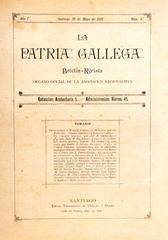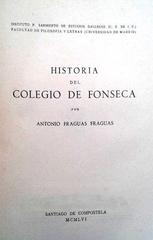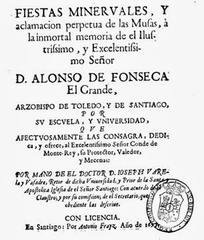
Cathedral of Santiago de Compostela: Visiting Hours, Tickets, and Travel Guide
Date: 03/07/2025
Introduction
The Cathedral of Santiago de Compostela stands as one of Spain’s most revered monuments, deeply rooted in religious tradition and cultural heritage. As the culminating point of the Camino de Santiago, it draws hundreds of thousands of pilgrims and travelers annually. Whether you are seeking spiritual fulfillment, architectural marvels, or a journey through centuries of history, this detailed guide will provide everything you need to plan your visit—including visiting hours, ticketing, accessibility, and insider tips.
Table of Contents
- Historical Overview
- Practical Visitor Information
- Religious and Cultural Significance
- Architectural and Artistic Legacy
- Surroundings and Nearby Attractions
- Frequently Asked Questions (FAQ)
- Conclusion and Further Resources
Historical Overview
Origins and Early History
According to legend, after the martyrdom of the Apostle St. James the Greater, his followers brought his remains to northwest Spain, where they were lost to history until rediscovered in the 9th century. Guided by mysterious lights, a hermit named Pelayo uncovered what was believed to be St. James’s tomb (walkthecamino.com). King Alfonso II of Asturias commissioned a chapel to enshrine the relics, marking the start of Santiago as a sacred destination (goaskalocal.com). The site quickly became a center for Christian pilgrimage, and subsequent churches were constructed as the destination’s fame spread (caminoways.com).
Construction and Architectural Evolution
The present cathedral was begun in 1075 during the reign of Alfonso VI. Its original Romanesque design featured massive stone walls, rounded arches, and barrel vaults, providing both aesthetic grandeur and the capacity to welcome large numbers of pilgrims (spainguides.com). Over the centuries, the cathedral expanded to include Gothic, Renaissance, Baroque, and Neoclassical elements, reflecting changing artistic trends and the city’s growing importance (caminoways.com; mexicohistorico.com).
Notable Artistic Features
- Pórtico da Gloria: Crafted by Master Mateo in the late 12th century, this Romanesque portal is adorned with over 200 expressive biblical figures and considered a masterpiece of medieval sculpture (caminoways.com).
- Botafumeiro: The famous giant silver thurible, installed in the 19th century, swings across the nave during special masses, symbolizing purification (caminoways.com).
Practical Visitor Information
Visiting Hours
- General Opening: Daily, 7:00 AM – 8:30 PM (hours may vary during religious holidays and events).
- Pilgrim’s Reception Office: Monday–Saturday 10:00 AM–6:30 PM; Sunday 10:00 AM–2:00 PM.
Always confirm current hours on the official website before your visit.
Ticketing
- Main Cathedral: Free entry for worshippers and general visitors.
- Special Areas: Tickets required for the museum, Pórtico da Gloria, rooftop tours, and Gelmírez Palace. Prices usually range from €6–€15.
- Booking: Strongly recommended to book in advance, especially during peak pilgrimage seasons (NomadTreneur; Camino Forum).
Accessibility
- The main nave and most public areas are accessible to visitors with reduced mobility via ramps and elevators.
- Some areas (crypt, rooftop tours) may involve stairs and uneven surfaces.
- Accessible restrooms are provided; inquire at the reception for assistance.
Guided Tours and Audio Guides
- Guided tours (in multiple languages) and audio guides are available for deeper insight into the cathedral’s history and art.
- Downloadable apps like Audiala offer interactive experiences.
Dress Code and Etiquette
- Modest dress is required: shoulders and knees should be covered.
- Silence and respectful behavior are expected inside.
- Photography is permitted in most areas but never with flash.
Travel Tips and Facilities
- Arrive early in the morning or late in the afternoon to avoid crowds.
- Restrooms and cloakrooms are available within the complex.
- The cathedral is centrally located in the Old Town, close to cafés, restaurants, and other amenities.
Religious and Cultural Significance
The Tomb of St. James
The crypt beneath the main altar houses the relics of St. James the Greater, making this cathedral one of the three principal pilgrimage destinations in Christianity, alongside Rome and Jerusalem (caminoways.com; britannica.com).
Pilgrimage and Rituals
The cathedral is the endpoint of the Camino de Santiago, with routes converging from across Europe. Pilgrims present their “credencial” at the Pilgrim’s Office to receive the official Compostela certificate. Unique rituals include hugging the statue of St. James and participating in the Pilgrim’s Mass, often highlighted by the swinging of the Botafumeiro (britannica.com; packing-up-the-pieces.com).
Special Events
- Feast of Saint James (July 25): Marked by processions, concerts, and cultural celebrations.
- Holy Years: When July 25 falls on a Sunday, the Holy Door is opened, and special indulgences are granted (Caminosantiagocompostela.com; Camino de Santiago Forum).
Architectural and Artistic Legacy
The cathedral is a living chronicle of European architecture, blending Romanesque, Gothic, Baroque, and Neoclassical styles (caminoways.com). The Portico of Glory and the Baroque Obradoiro façade are standout features, while the Botafumeiro and high altar contribute to the cathedral’s unique character. Recent restoration projects, such as the conservation of the Pórtico da Gloria, have preserved these treasures for future generations.
Surroundings and Nearby Attractions
The cathedral is the centerpiece of Santiago’s UNESCO-listed Old Town, surrounded by grand plazas:
- Praza do Obradoiro: The cathedral’s main square, perfect for admiring the façade.
- Hostal dos Reis Católicos: Former pilgrim hospital, now a luxury hotel.
- Monastery of San Martiño Pinario and Museum of Pilgrimage and Santiago: Worth visiting for additional historical context.
- Alameda Park: Offers panoramic views of the cathedral.
Souvenir shops sell scallop shells (the symbol of the pilgrimage), silver jewelry, and the famous Tarta de Santiago almond cake.
Frequently Asked Questions (FAQ)
Q: What are the visiting hours?
A: Generally 7:00 AM–8:30 PM, with variations during holidays.
Q: Is there an admission fee?
A: Entry to the main nave is free. Tickets are needed for special areas and tours.
Q: Are guided tours available in English?
A: Yes, as well as in other major languages.
Q: Is the cathedral accessible for those with reduced mobility?
A: Most main areas are accessible; rooftop and crypt tours may involve stairs.
Q: When is the best time to visit?
A: Early morning or late afternoon outside July and August.
Q: How do I get the Compostela certificate?
A: Present your completed pilgrim passport at the Pilgrim’s Office.
Q: Can I take photos inside?
A: Yes, but without flash.
Conclusion and Call to Action
The Cathedral of Santiago de Compostela is more than a monument; it is a living center of faith, art, and intercultural exchange. Whether you are drawn by its legendary history, architectural splendor, or the spiritual journey of the Camino, your visit promises to be memorable. For up-to-date information and to enrich your experience, consider using the Audiala app for audio guides and interactive maps. Explore additional resources and related articles on pilgrimage routes and Santiago’s historical sites to make the most of your journey.
Further Reading and Official Sources
- Walk the Camino: History of the Cathedral
- Patheos: Cathedral of Santiago de Compostela
- CaminoWays: Cathedral of Santiago de Compostela
- NomadTreneur: Cathedral Travel User Guide
- Britannica: Camino de Santiago
- Caminosantiagocompostela.com: Ultimate Visitor Guide
- Packing Up The Pieces: Pilgrim Guide
Images and interactive maps are recommended for a richer visual experience. Optimize alt text for improved accessibility and SEO (e.g., “Cathedral of Santiago de Compostela main façade”, “Portico of Glory detail”).




